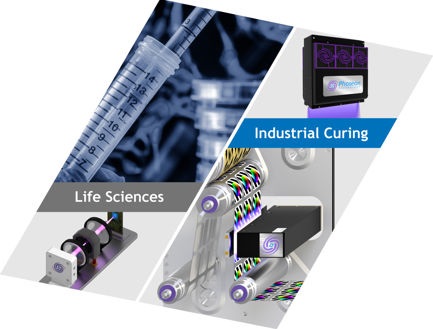UV LED curing technology presents numerous opportunities for wide web applications due to all of its inherent advantages. Although most applications on the market today are in digital inkjet, screen, narrow web flexographic and sheet-fed offset printing, and structural bonding, Phoseon Technology sees growing interest in UV LED for wide web applications.
 |
|
(Image: Phoseon Technology) |
Laminating Adhesives – Viable Today
UV LED Laminating Adhesives is an area of focus for Phoseon. The benefits of UV LED laminating include an immediate cure and a long pot life — also known as working life, or the period that chemicals remain usable when mixed. In addition, using laminating adhesives, as opposed to solvent-less adhesives, enables the laminated web to be slit, converted and filled immediately after the laminator with no controlled environment post-cure processing time requirements.
Wide Web Coating Applications — Next on the Horizon
The wide web market currently uses traditional UV curing systems for protective varnish, silicone release and functional coatings, but businesses are starting to invest time and resources into developing UV LED solutions for their coating applications.
“Companies have started to integrate UV LED curing into their wide web coating lines because of the benefits and growing level of interest in the use of UV LED sources within this application space,” said Jennifer Heathcote, Director of Business Development at Phoseon Technology. “While it is likely some applications may not yet be viable for LED today, there are several coating lines that are successfully being converted, and this trend is expected to grow in the coming years.”
In addition, wide web UV applications that were never achievable with conventional arc or microwave systems due to the large degree of heat transfer, are becoming possible with LED, thus expanding the total UV curing market.
Most of the UV LED formulation work over the past 10 years has been in the areas of inks, adhesives and over-protective varnishes. Many coatings companies are just now starting to evaluate UV LED curing systems for use in curing b-stage, functional, and hard coat chemistry.
“The fact that UV LED coating formulations are garnering attention suggests the latest improvements in the technology are making it increasingly viable — technically and economically — for use in wide web coatings applications,” Heathcote said. “UV equipment suppliers have achieved success in designing and producing UV LED curing systems in short head lengths, and these designs are rapidly being extended to longer lengths.”
Heathcote says that while there are upfront costs to begin using, or switching to, UV LED curing for wide web printing, companies often quickly recoup their investment. UV LED curing systems have no moving or consumable parts, virtually eliminating down-time for maintenance and repairs.
“Unlike arc lamps, which have a lifecycle of approximately 1,000 hours, UV LED bulbs have an extremely long life and require less energy to operate, reducing operation costs and energy usage by up to 70 percent,” Heathcote said. “Furthermore, UV LED bulbs can be turned on and off without a warm-up period and have a consistent light intensity through their life, where arc light intensity tends to deteriorate as the bulb ages.”
Wide Web Printing Applications — Moving into the Future
While the vast majority of wide web printing applications today use water- and solvent-based inks, which often are followed by an off-line UV varnish, there is an opportunity to move to inline UV for both inks and coatings on these applications. The chemistry is now increasingly available, technology has improved, the overall cost is lower than it was when it was first introduced to the market and, most importantly, UV LED systems can be designed so they are effectively integrated into the configurations of wide web presses.
Heathcote notes that UV LED curing systems offer better performance and quality control than conventional sources. UV LEDs eliminate constantly degrading bulbs that produce a broad band spectral output that is only slightly-alterable due to the physics of vaporized mercury. Instead, UV LEDs produce a consistent spectral output with a nearly infinite adjustment in peak irradiance that can be scaled up and down with web speed.
In addition to wide web printing, Phoseon Technology’s UV LED technology also is used in a wide range of other applications, including narrow web and decorative printing, manufacturing wood, and curing wood and filament coatings.












